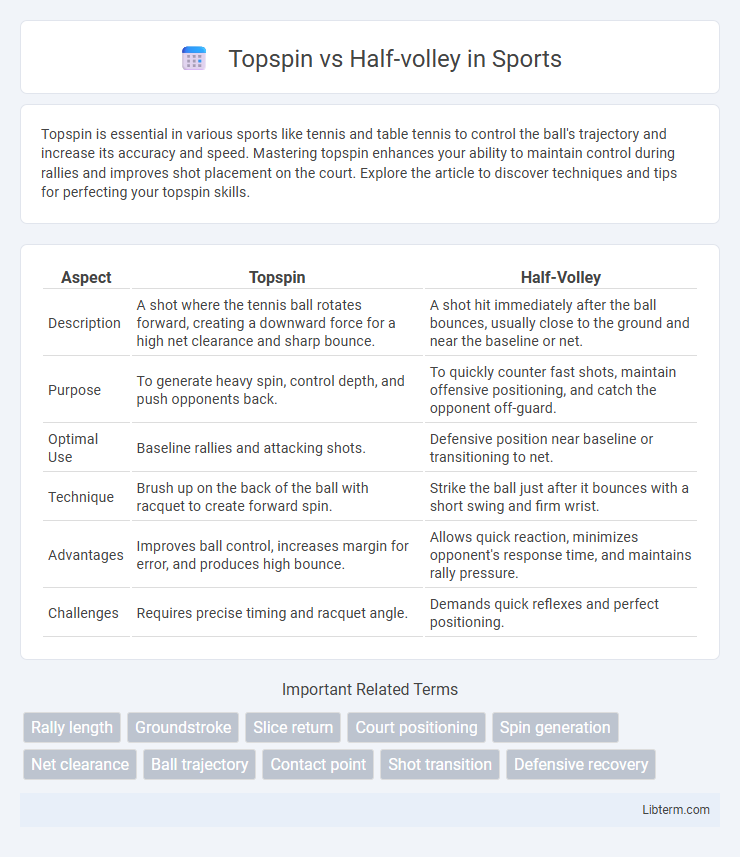Topspin is essential in various sports like tennis and table tennis to control the ball's trajectory and increase its accuracy and speed. Mastering topspin enhances your ability to maintain control during rallies and improves shot placement on the court. Explore the article to discover techniques and tips for perfecting your topspin skills.
Table of Comparison
| Aspect | Topspin | Half-Volley |
|---|---|---|
| Description | A shot where the tennis ball rotates forward, creating a downward force for a high net clearance and sharp bounce. | A shot hit immediately after the ball bounces, usually close to the ground and near the baseline or net. |
| Purpose | To generate heavy spin, control depth, and push opponents back. | To quickly counter fast shots, maintain offensive positioning, and catch the opponent off-guard. |
| Optimal Use | Baseline rallies and attacking shots. | Defensive position near baseline or transitioning to net. |
| Technique | Brush up on the back of the ball with racquet to create forward spin. | Strike the ball just after it bounces with a short swing and firm wrist. |
| Advantages | Improves ball control, increases margin for error, and produces high bounce. | Allows quick reaction, minimizes opponent's response time, and maintains rally pressure. |
| Challenges | Requires precise timing and racquet angle. | Demands quick reflexes and perfect positioning. |
Understanding Topspin: Key Characteristics
Topspin is characterized by a forward spin that causes the ball to dip sharply and bounce higher upon landing, enhancing control and aggressive shot-making in tennis. This technique increases ball speed and trajectory stability, allowing players to maintain powerful groundstrokes with precision. Mastering topspin improves rally endurance and shot consistency, contrasting with the half-volley's emphasis on timing and quick reaction near the net.
The Mechanics of the Half-volley
The mechanics of the half-volley involve hitting the ball immediately after it bounces, requiring precise timing and a compact swing to maintain control and accuracy. Unlike a topspin stroke, which emphasizes brushing up the back of the ball to generate spin and lift, the half-volley demands a more horizontal racquet path to neutralize the ball's momentum. Proper footwork and body positioning are crucial in executing an effective half-volley, allowing players to quickly recover and prepare for the next shot.
When to Use Topspin in Tennis Matches
Topspin in tennis is most effective when aiming to control the ball's trajectory and generate a high bounce, making it ideal for baseline rallies and aggressive offense. Players use topspin to push opponents behind the baseline by increasing shot safety and reducing unforced errors on groundstrokes. When facing fast or low balls, applying topspin helps maintain consistency and enables better shot placement during rallies.
Situational Advantages of the Half-volley
The half-volley offers distinct situational advantages by allowing players to counteract low, fast shots close to the net, maintaining offensive pressure with controlled returns. Its execution helps neutralize opponents' powerful volleys by minimizing reaction time and exploiting transitional moments after the ball bounces. In fast-paced rallies and tight court positioning, the half-volley provides strategic versatility, enabling effective responses when traditional topspin strokes are less feasible.
Technique Comparison: Grips and Stance
Topspin shots typically use a semi-western or western grip, allowing the player to brush up the back of the ball for maximum spin, while half-volleys often employ a continental grip to maintain control and quick reflexes near the net. The stance for topspin involves a more open or neutral position, enabling forward and upward racket motion, whereas half-volley technique requires a closed or sideways stance to handle the ball closely after it bounces. Effective execution of both requires precise foot positioning and wrist control tailored to their distinct stroke dynamics.
Ball Trajectory: Topspin vs Half-volley
Topspin generates a high arc and forward rotation, causing the ball to dip sharply and accelerate upon bouncing. Half-volleys produce a flatter trajectory with minimal spin, resulting in a lower, faster ball staying close to the net after the bounce. The differing trajectories influence shot placement and opponent response, with topspin favoring controlled depth and half-volleys emphasizing quick reactions.
Common Mistakes and How to Avoid Them
Topspin and half-volley shots often suffer from common errors such as incorrect timing and improper racket angle, leading to weak or inaccurate returns. Many players mishandle topspin by not brushing up enough on the ball, which reduces spin and control, while half-volleys typically fail due to poor foot positioning and delayed contact. To avoid these mistakes, focus on early preparation with a slightly closed racket face for topspin and maintain a balanced stance with a firm wrist for half-volley execution.
Impact on Game Strategy and Tactics
Topspin generates a heavy, forward-rotating ball trajectory that enhances control and allows aggressive baseline play, pressuring opponents with consistent deep shots. In contrast, the half-volley, executed immediately after the ball bounces, shortens reaction time and disrupts opponents' rhythm, making it effective for approaching the net and forcing errors. Utilizing topspin emphasizes rally endurance and shot placement, while half-volley tactics prioritize quick decision-making and positioning to capitalize on opponents' weak returns.
Professional Players: Signature Shots
Topspin and half-volley shots serve as signature techniques for many professional tennis players. Rafael Nadal's heavy topspin forehand generates high bounce and aggressive angles, making it one of the most effective shots on the ATP Tour. Conversely, Roger Federer utilizes the half-volley masterfully to redirect fast-paced shots close to the net, showcasing exceptional timing and court positioning.
Choosing the Right Shot Under Pressure
Topspin generates aggressive forward rotation that enhances ball control and depth, making it ideal for maintaining offensive pressure during rallies. Half-volleys require precise timing and quick reflexes as the ball is struck just after it bounces, offering a strategic response to fast-paced shots and minimizing opponent's reaction time. Selecting the right shot under pressure depends on positioning, ball trajectory, and opponent's stance, with topspin favored for controlled attacks and half-volley for sudden, close-to-net responses.
Topspin Infographic

 libterm.com
libterm.com